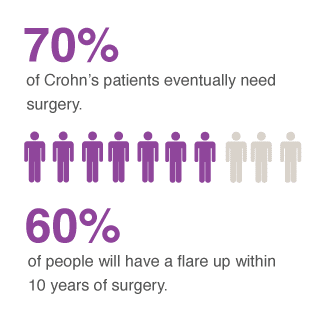Crohn’s disease is a chronic disease that is classified under the inflammatory bowel disease category. The disease is caused when an abnormal immune system response triggers an inflammation in the digestive tract. It occurs when the immune system mistakenly attacks the good bacteria in the gastrointestinal tract. When this happens, the walls of the intestines thicken and cause the symptoms associated with this disease.
Unlike ulcerative colitis which also falls in the IBD category and affects the large intestines, Crohn’s disease affects the whole digestive tract from the mouth to the anus. Although the symptoms are similar, a proper doctor can differentiate the two. One can only get infected with one but not both of these diseases.
Although it can occur in any part of the gastrointestinal tract, the colon and the lower part of the small colon are more susceptible to infection. When the lining is inflamed, the body’s ability to digest food is interfered with. The absorption of nutrients is interfered with as well. When infected with this disease, your body is unable to eliminate waste in a healthy manner. When these activities happen, you might experience symptoms such as cramping, abdominal pain, gas, diarrhea, bloating and appetite loss.
Read more about this in our in-depth article on Crohn’s disease.
Crohn’s Disease Statistics and Facts
- 700,00 Americans are infected with Crohn’s Disease according to Crohn’s and colitis foundation of America.
- In the year between 1992 and 2004, 800,000 patients were reported to have visited physicians in different parts of the country with cases of Crohn’s disease.
- In the year 2004, Crohn’s disease was the sole cause of 57,000 hospitalizations in different parts of the US.
- This IBD chronic condition is reportedly more rampant in boys compared to girls.
- It occurs mostly in young adults between the ages of 15 to 30. However, studies on patients of Crohn’s disease indicate that a majority of them first experienced initial symptoms at the age of 20.
- Studies show that Crohn Disease is most likely to occur to individuals who live in highers latitudes compared to those who live in low latitudes.
- Children have been noted to be twice as much likely to contact Crohn’s disease more than anyone else. This is so because most patients range from the age of 15. However, it rarely affects children under the age of 8.
- In the United States, some ethnicities such as jews and Caucasians are likely to develop this chronic disease faster than other ethnicities. African Americans are most likely to have the disease in the upper GI tract or the colon.
- Cases of Crohn’s Diseases are more rampant in developed countries with more urban areas and southern climates compared to second and third world countries.
- There is no known cause of the Crohn’s Disease, but research shows that it may be hereditary. Studies show that 5%-20% of the patients of this disease have a parent, sibling or child who’s infected with the disease. This is according to data according to multicenter African American IBD study.
Further studies on this disease also show that this disease is caused by a combination of factors, some of which are unknown hence making the exact cause difficult to tell - Stress and a poor diet may make the condition worse. This is because these two work by weakening the immune system and interfering with the GI lining which leads to making the disease worse than it already is and the symptoms unbearable.
- Most patients of the Crohn disease are known to experience episodes of disease activity which is then followed by remission.
- The patients are known to experience anxiety and social withdrawal symptoms with each episode of a flare-up of the disease.
- There is no single test that can certainly diagnose this problem. A doctor will perform several tests and rule out other diseases before knowing for sure that one is suffering from Crohn’s disease.
- There are 177 pharmaceutical products worldwide meant for the treatment of Crohn’s disease and 52 pharmaceutical products in the trial for the same.
- Studies show that patients diagnosed with moderate to severe Crohn’s Disease have a high risk of premature death which is the same case for moderate cigarette smokers.
- Tests performed on 50, 000 Canadians suffering from the Crohn’s disease showed that as the disease progresses and the GI lining gets sensitive and more inflamed, patients have been known to develop lactose intolerance.
- Studies performed by Deloitte Access Economics in Australia and landmarked by The Economic Cost of Crohn’s Disease and Ulcerative Colitis showed that 2.7 million was spent on this disease in the year 2007 in Australia.
- With medical and surgical treatment, studies show that 50% of the patients will be remission or experience the symptoms of the disease mildly for the next 5 years while 11% of these people will experience chronically active disease.
- 70% of the patients who experience active disease in a certain year are bound to experience another episode of activity the following year.
- 8%-16% of IBD cases are diagnosed in patients who are 60 years of age and beyond. Although the symptoms are the same as of those diagnosed in their teens, diarrhea and bleeding are more rampant in the older patients.
- Studies have shown that older patients of more than 60 years of age are twice as more likely to experience drug-related adverse effects compared to the younger patients.
- Up to 70% of the patients afflicted by the Crohn’s disease eventually require surgery.
- Patients of IBD are at an increased risk of developing other diseases such blood clots, colon cancer and a liver disease known as primary sclerosing cholangitis (PSC).
- Studies show that people with IBD are at a greater chance of developing Deep Vein Thrombosis compared to the other people in the population.
- 33% of the patients of this IBD experience complications inside the GI tract at the moment of diagnosis while 50% of the patients experience the same complications within the first 20 years of diagnosis.
- A number of hospitalized patients were stable in the year 1979 to 1990, but then the numbers have continuously gone higher with time.
- Although there is no known cure for Crohn’s disease, the symptoms can be controlled especially for patients in the early stages and those that have undergone surgery.
Sources
- http://www.ccfa.org/resources/facts-about-inflammatory.html
- https://www.crohnsandcolitis.com.au/research/studies-reports/
- http://www.healthline.com/health/crohns-disease/facts-statistics-infographic
- https://crohnsandcolitis.ca/about-crohn-s-colitis/what-are-crohns-and-colitis
- http://www.cdhf.ca/en/statistics

